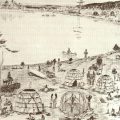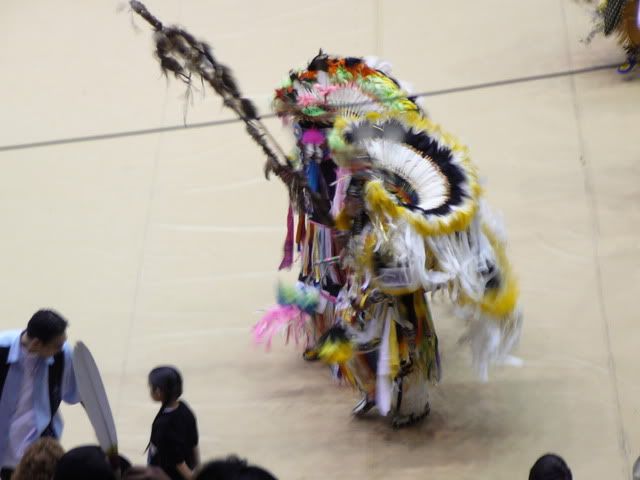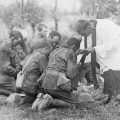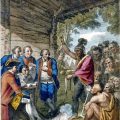For many non-Indians, any discussion of modern Indians brings forth an image of casinos. For some people, this image of tribal casinos is a good one: one that brings forth memories of good times, good entertainment, and good food. For others, it brings forth an image of corruption, greed, evil, sin, and all of the things that are bad with our society. Five hundred years ago Indians were gambling. Traditionally, before the coming of the Europeans, gambling was a part of their recreation, a part of their economic system, and a part of their religious systems. There were, however, no casinos in America when the Puritans and the Spanish arrived here.

During the Reservation Era in the United States during the nineteenth and twentieth centuries, the federal government worked hard to suppress all forms of Indian gambling, ranging from the traditional horse races and stick games, to the recent innovations of playing cards. Eventually, Indian casinos-a form of European gaming-arose not because the government encouraged them, but because Indians fought for them in the courts and in Congress.

The Courts:
In 1980, the Cabazon Band of Mission Indians in California opened a small poker room. At this time, poker rooms were legal in California and found in many communities. However, a few days after the Cabazon poker room was opened, the Indio Police Department, with officers in full riot regalia, seized the poker tables, arrested the patrons, and confiscated the poker chips.
Since Indio did not allow gambling by local ordinance, the Cabazon were required to win a referendum. The referendum to allow them to have a poker room was defeated.
In 1983, the Cabazon tried again, this time with a Bingo Palace. Once again their gaming operation was shut down by local law enforcement (the Riverside County Sheriff.) The tribe, however, took their case to court and won an injunction against the county. The county appealed.
Court cases in the United States, particularly those concerning Indian nations, generally proceed rather slowly. In 1986, the Ninth Circuit Court of Appeals ruled that Riverside County has no right to prohibit gambling on the Cabazon Reservation. As a federally recognized Indian tribe the Cabazon are a sovereign nation. The state of California appealed the ruling.
In 1987, the United States Supreme Court in California versus Cabazon Band of Mission Indians held that state gaming laws have no force in Indian country if the type of gaming does not violate the state’s public policy. In this decision the court acknowledged the retained right of tribes as sovereign nations to engage in gaming without state interference as long as gaming of some form was legal in that state. If the tribe’s gaming is to be regulated from the outside, it must be regulated by Congress, not California. Justice Byron White, writing for the majority, finds:
“Tribal sovereignty is dependent on, and subordinate to, only the Federal Government, not the States.”
Twenty-one states supported California against the tribes in this case. Federal courts and the Supreme Court have long recognized two basic things: (1) under the constitution of the United States, Indian tribes are sovereign nations which are not under the jurisdiction of the state in which they are found, and (2) the states are often the worst enemies of the tribes which are found within their borders.
In 1886, the Supreme Court in United States versus Kagama pointed out that with regard to Indian tribes:
“the people of the states where they are found are often their deadliest enemies.”
Consistently the actions of the states have not been in the best interests of the Indian nations within them. Even when the presence of the Indian casinos has been shown to be an economic benefit to the state, the states have tended to oppose Indian casinos.
Congress Steps In:
As often happens when the Supreme Court makes a ruling that reinforces tribal sovereignty, non-tribal interests turned to the United States Congress for help. In 1988, Congress passed the Federal Indian Gaming Regulatory Act (IGRA) in response to the Cabazon court case. This act allows tribes to operate casinos.
Under IGRA, casinos are allowed on Indian lands if such gambling is: (1) located in a state which permits such gaming for any such purpose by any person, organization, or entity, and (2) conducted in conformance with a Tribal-State compact entered into by the Indian tribe and the state. Thus, if the state allows “Casino Nights” or “Las Vegas Events” for charitable groups such as churches, then the first part of this condition is met.
IGRA defines three classes of Indian Gaming:
Class I consists of traditional Indian gambling which is often done as a part of ceremonies and powwows
Class II includes bingo and similar forms of gaming
Class III includes slot machines, baccarat, blackjack, and other casino games
Under the provisions of IGRA, Class II and Class III gaming are under the supervision of an Indian Gaming Commission.
The goal of the IGRA was to regulate Indian gaming operations as well as to provide some federal protection for tribes from state governments, which in many cases tried to curb Indian operations.
John McCarthy, the executive director of the Minnesota Indians Gaming Association, has commented that:
“neither the tribes nor Congress imagined the phenomenal success it would become (if Congress had, it is quite likely that the act never would have been passed in the first place.)”
The Impact of Casinos:
In general, Indian casinos have been the most successful form of economic development on the reservations. At the present time, there are 239 tribes operating 448 gaming businesses in 26 states. In 2010 gaming revenues from Indian casinos were $26.7 billion. With the recession, revenues have declined slightly.
Unlike the profits from privately owned casinos which are used to enrich very wealthy people, the profits from Indian casinos are invested in the tribe. This investment includes cultural investment (museums, interpretive centers, language retention programs), tribal health care, tribal housing, and tribal education.
Indian casinos provide about 682,000 jobs, most of which are held by non-Indians. While non-Indian employment boosts the economies off-reservation, some of the anti-Indian folks use this fact to condemn the casinos. There is the delusion that casinos should provide employment for tribal members, but the reality is that the tribal members own the casino. There is no expectation that non-Indian casinos’ work should provide employment for their owners.
A recent study by the Institute on Poverty at the University of Wisconsin-Madison found a correlation between Indian casinos and improved physical and mental health. The study found that casinos raise household incomes by an average of $1,750. With casinos the probability of smoking was reduced by 9.6% and the probability of heavy drinking by 5.2%.
For non-Indians, Indian casinos have allowed them to coat their anti-Indian racism with a very thin veneer of moral outrage against gaming (although many of these same people support these same activities when the profits go to non-Indian people or institutions).





Leave a Reply